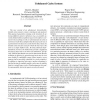Free Online Productivity Tools
i2Speak
i2Symbol
i2OCR
iTex2Img
iWeb2Print
iWeb2Shot
i2Type
iPdf2Split
iPdf2Merge
i2Bopomofo
i2Arabic
i2Style
i2Image
i2PDF
iLatex2Rtf
Sci2ools
86
Voted
MTDT
1999
IEEE
1999
IEEE
Unbalanced Cache Systems
The new concept of an unbalanced, hierarchicallydivided cache memory system is introduced and analyzed. This approach generalizes existing cache structures by allowing different memory references (e.g. as possibly unevenly divided within an address-space) to be subject to various levels of caching as well as varied amounts of cache at each level. Under the assumption that the total cache size at a particular level is fixed, it is easily shown that at least one divided cache structure exists for which the miss-rate is the same as a single unified cache. By using alternate implementations, however, the method may provide a significant decrease in miss-rates as is shown via simulations. Specifically, SPEC95 benchmarks are used to demonstrate that the technique is effective for general usage but it may be even more useful for embedded systems where memory access patterns can be more fully controlled (i.e. via the compiler). In addition to improved miss-rates, another advantage is that the...
Cache | Cache Memory | Cache Structure | Hardware | MTDT 1999 |
Related Content
| Added | 04 Aug 2010 |
| Updated | 04 Aug 2010 |
| Type | Conference |
| Year | 1999 |
| Where | MTDT |
| Authors | David L. Rhodes, Wayne Wolf |
Comments (0)

